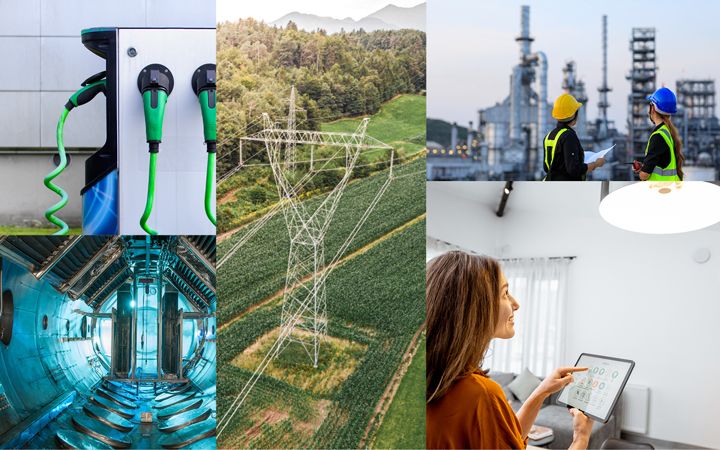
Leveraging AI tools for utility data enrichment
Utilities are navigating a new era shaped by evolving customer expectations, accelerated digital transformation, and a generational shift in how businesses make decisions. With millennial and Gen Z leaders driving demand for personalized, tech-forward engagement—and employee turnover shortening institutional memory—customer outreach must be dynamic, accurate, and actionable.
Despite these shifts, many utilities still rely on outdated, fragmented data systems that provide only a surface-level view of their business customers. Without deeper insights into customer needs and behaviors, it becomes difficult to identify key decision-makers or deliver key messages that foster long-term engagement. These data gaps undermine marketing efforts and ultimately hinder customer satisfaction and participation.
To address these challenges, utilities must start with a solid data strategy: organizing, cleansing, and enriching data to fill gaps. By leveraging advanced analytics and AI, utilities can transform their data management practices, leading to significant productivity gains and more informed business decisions.
The current state of data management at utilities
Many utilities still rely on legacy data systems built around meters and billing, instead of people or businesses. As a result, they have limited insight into their business customers beyond basic account details—restricting their understanding of energy usage patterns, customer preferences, and opportunities for engagement in energy efficiency programs. This lack of detailed customer data hampers their ability to target and connect with the right businesses and decision-makers.
Key pain points include:
- Incomplete contact information
- Outdated records
- Limited visibility into business characteristics such as business type and ownership status
- Inconsistencies between datasets
These gaps make it nearly impossible to deliver personalized experiences or effective outreach. To overcome this, utilities must invest in cleansing, enriching, and organizing disparate datasets to accurately identify and engage the right contacts at top businesses.
Centralized data enables utility-wide insights
Addressing these challenges starts with how data is collected and connected. Utilities need a centralized repository system to collect all the data from many different sources, such as event lists, Customer Relationship Management (CRM) systems, program participation/applications, website forms, Customer Information Systems data, Advanced Metering Infrastructure data, etc. To be effective, any customer program platform needs to:
- Integrate with utility data, capturing key details like usage patterns and participation rates.
- Enrich that data to fill in the gaps such as firmographic, geographic, and contact information.
- Understand the complexities of relationships like those between parent and child companies, managed accounts, national accounts, and contractor networks—creating a more complete picture of the customer landscape.
- Feed cleaned up data and target segments into your martech tools to execute your campaigns.
Key insight: Utilities must break down data silos to create a centralized, accessible repository. Integration across departments ensures a unified customer view and eliminates redundancies.


AI-powered data enrichment
AI is revolutionizing data management and analytics by automating tasks, improving data quality, and providing deeper insights. Although AI has become a buzzword, AI techniques like machine learning and natural language processing have been around for a while and can handle large datasets, identify patterns, and make predictions, enhancing accuracy and efficiency.
Key insight: AI is a powerful tool that can help utilities with data enrichment. According to ICF research, 48% of utilities are already using AI to help them identify customer segments and targets.
Data enrichment enhances the value of existing data with additional information. AI’s sophisticated algorithms and predictive analytics tools can help fill numerous data gaps and provide valuable insights such as:
- Predicting an account’s business type and identifying accounts that may be related under the same parent company, such as state or local governments, school districts, campus systems, or national chains.
- Identifying businesses with certain energy use signatures that make them ideal candidates for specific energy savings opportunities.
With this enriched data, utilities can build targeted segments that align with their business goals.
Each type of AI tool comes with its own set of challenges and opportunities for utility marketing. Traditional AI techniques, long used across the industry, are well suited for classification efforts and predictive analytics. Generative AI (GenAI), which has rapidly advanced in recent years, uses deep learning and massive datasets and is well suited to synthesize data insights and create new content such as text and visuals.
Data privacy and governance
The use of AI, particularly GenAI, raises significant data privacy concerns. Consider setting up an internal team that is responsible for promoting the responsible and sustainable use of generative AI solutions.
AI data policy standards every utility should meet
Third-party data providers
In today’s digital world, data is paramount. While first-party data—gathered directly from customer interactions—is among the most accurate and trusted, it can also be costly and slow to collect at scale. To fill gaps and accelerate insights, utilities and their partners turn to reliable third-party data sources to enrich existing records with additional details such as business type, contact information, or behavioral signals.
Key insight: With a multitude of vendors in the market, selecting the right third-party data provider is crucial. It requires a strategic approach to ensure data quality, relevance, and compliance with industry standards.
Before diving into the selection process, it's essential to clearly define your data requirements. Identify the specific data points you need, such as contact information, firmographics, building characteristics, and more. This will help you narrow down providers that specialize in the data types relevant to your business.
Track down which data fields you’re able to get from cross-functional teams (customer service CRMs, program applications, etc.). Then establish a streamlined, repeatable process for getting this internally sourced data back into your centralized repository, reducing manual workload.
Here are additional factors to consider when onboarding a third-party data provider:
- Understand data acquisition practices: Look for providers that use diverse and reliable sources.
- Review data refresh frequency: Choose a provider that regularly updates their data, so you always have access to the most current information.
- Assess security and compliance: Ensure that the provider adheres to strict security measures and relevant regulations to safeguard your data and maintain trust with your customers.
- Consider geographic coverage: Select a provider that covers the regions you operate in, whether it's city-specific or rural areas.
What utilities can do with all that data
Data—paired with the right analytics tools—empowers utilities to better understand customer behavior, personalize outreach, and drive stronger program performance. For example, ICF’s Sightline® platform doesn’t just collect data; we analyze it, identify patterns, and translate those into insights that fit the unique needs of each client.
Key insight: Only once you know who your customer is, can you successfully undertake critical marketing strategies.
Program design and customer offers: Design flexible, data-driven programs that adapt to evolving customer behaviors and energy demands. This approach integrates advanced data modeling and innovative technologies to support revenue growth, grid reliability, and improved customer outcomes.
Target scoring: Identify and prioritize high-value customers, which will allow you to evaluate and rank potential customers or leads based on their likelihood to engage with your products or services. This scoring helps utilities prioritize efforts and resources towards the most promising prospects.
Market characterization and segmentation: Understand the unique characteristics of different market segments and tailor your strategies to meet their specific needs. Start by researching specific sectors, then create personalized customer journeys and messaging for different segmentation. Segment customers not just by business type, but job function of the decision maker, by where they are in the funnel or by how engaged they are with your content.
Account-based marketing (ABM) strategy: Focus on personalized marketing efforts for ideal account targets. You can think of ABM as an added layer in the marketing you’re already doing to raise awareness and to promote your programs and offers.
Campaign execution: Implement targeted marketing campaigns that resonate with your audience, driving higher engagement and conversion rates. Integrate with your martech tools and start to automate these processes.
Campaign performance: Measure and analyze the performance of your campaigns to continuously optimize and improve your marketing efforts. Integrate key marketing data into your centralized data system to maximize insights.
Future forward
Ultimately, the adoption of AI tools for data enrichment empowers utilities to better understand customer behavior, personalize outreach, and drive stronger program performance. As utilities continue to navigate the evolving energy landscape, leveraging AI will be key to achieving long-term success and building lasting customer engagement.
